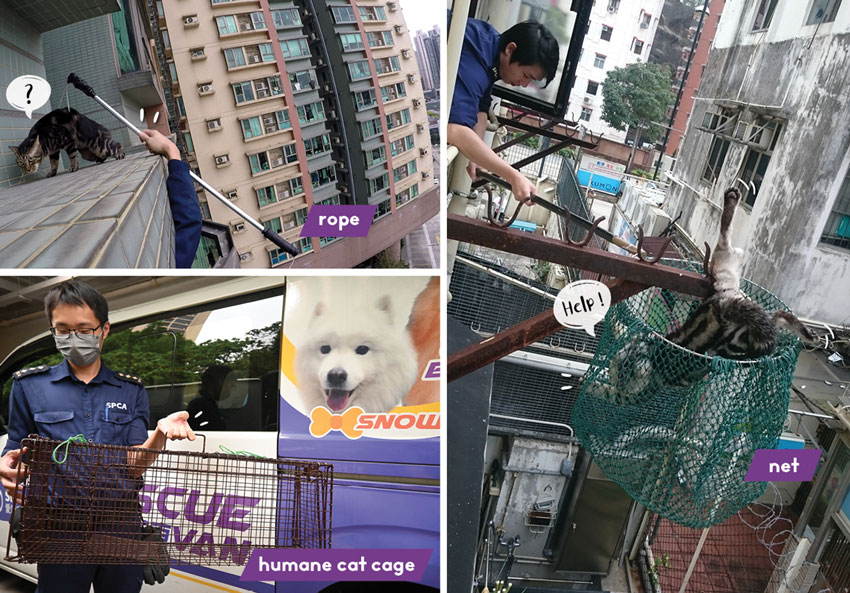Cats On the Windowsill

To curious cats, the world is full of wonders. It is no surprise to find them venture out of their comfortable home and sit precariously on some windowsill at a high-rise building.
From 2021 to 2022 alone, the SPCA inspectors received more than 220 calls for help related to such "windowsill cats". That makes an average of nearly 20 cases per month. Unfortunately, in 25% of these cases, the cats had already fallen to death or disappeared without a trace before the arrival of our inspectors.
Saving animals trapped at high-altitude places requires high EQ, wits and lots of physical strength. Felix, Chief Inspector of the SPCA, shares his action-packed experience.

According to Felix, when an inspector receives a call reporting on a windowsill cat case, he should first ask the informant to provide details of the location, best with a photo or a video, and the emotional status of the cat. Such information will help the inspector devise a rescue strategy and pick the right kind of rescue tools, such as ropes, nets and cages to help the troubled cat.
After arriving at the scene, the inspector will ask the owner, if present, for the details of the cat, including its personality and age as well as the duration of the ownership. Most importantly, the inspector needs to precisely assess the emotional state of the cat because a slight human movement, a loud noise or an unexpected appearance of a rescue tool will likely frighten the animal, causing it to stumble and fall.
The pictures in this article show vividly how challenging and dangerous a windowsill cat rescue can be - for both the saviour and the saved. The process can be as nerve-wracking as riding a rollercoaster and pump up the inspector's adrenaline.
Felix said, "During the rescue, the inspector is highly focused on the state of the cat. There is no chance for him to get distracted or feel frightened. Only after he saves the cat and puts it in a cage, heaving a sigh of relief, will he realise his heart has been beating so fast this whole time."
From Felix's experience, he believes that carefully observing the cat's movements, thinking from its perspective, and planning the appropriate strategy are the key to success.
He recalled one of the most memorable cases he had handled. "I was trying to save a cat trapped on a windowsill outside its owner's apartment. I saw it constantly looking at the other window of the apartment. So I asked the owner to slowly open that window and sure enough, the cat jumped back into the apartment through that window he couldn't take his eyes off from. Sometimes, good observation before rescue can help us save a lot of time and minimise the risks."
On another occasion, Felix had to save an adult cat which had just been adopted by its owner for a few days. The owner found that it was walking on top of several adjacent air-conditioners outside the apartment, so he called the SPCA for help.

Most apartments in Hong Kong are in high-rise buildings, making it more difficult to carry out a rescue.

First and foremost, observe the emotional state of the cat carefully. Do not do anything that may scare it lest it should stumble and fall.
Upon arrival at the scene, Felix started to worry that the nervous cat might fall into an unreachable corner if it made a jump forward. He set up a cat cage outside the window and put some food in the cage to lure it back to a safer place. Fortunately, the cat got so hungry the next day that it walked into the cage by itself, saving its own life.
Apart from cats, the SPCA inspectors have rescued other animals from window sills, such as dogs, rabbits, chinchillas and turtles. Usually such incidents happened because their owners had forgotten to close the windows properly, giving these naughty ones a chance to escape.
Over the years, Felix has also played the important role of an educational ambassador, teaching pet owners the importance of home safety for their little animals, installing cat nets on windows and balconies, and constantly paying attention to the animals' whereabouts.
Last but not least, Felix reminded people not to attempt to rescue animals trapped at high altitude. Without a well-thought-out plan, one might easily scare the nervous animal and cause injuries. In some situations, pet owners can try lure the animal back into a safe place with its favourite food.
In sum, a successful rescue requires professional knowledge, skills and experiences. Call the SPCA 24-hour rescue hotline at 2711 1000 if you spot an animal in need of help. Remember to provide clear descriptions of the location, ideally with a photo or video. This can help our inspectors come up with the best rescue strategy possible.

Ropes, nets and cat cages are commonly used for rescuing trapped cats.











